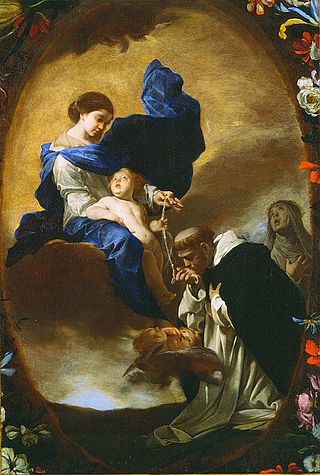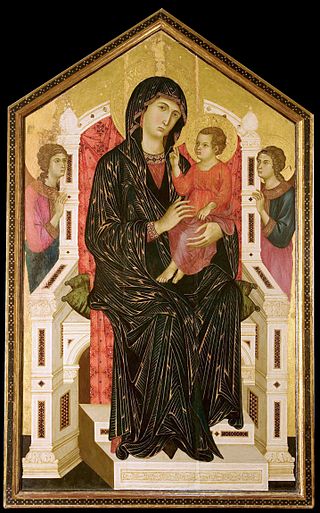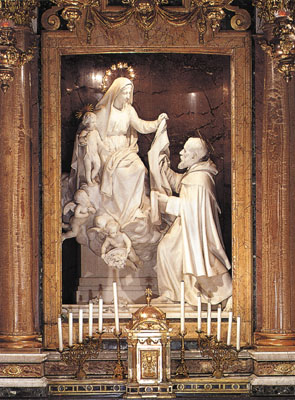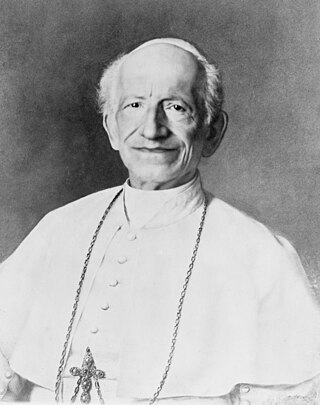Benefit of pious associations
While recognizing the natural tendency of people to associate in groups of like-minded interests, he notes the beneficial usefulness of various Catholic associations. Among these, however, he gives prominence to the Rosary Sodality. "Everyone knows how necessary prayer is for all men; not that God's decrees can be changed, but, as St. Gregory says, 'that men by asking may merit to receive what Almighty God hath decreed from eternity to grant them.'" [2]
"We are taught by the Catholic faith that we may pray not only to God himself, but also to the Blessed in heaven (Conc. Trid. Sess. xxv.), though in different manner; because we ask from God as from the Source of all good, but from the Saints as from intercessors. [...] Wherefore, it is said in the Apocalypse (viii.,4): 'The smoke of the incense of the prayers of the Saints ascended up before God from the hand of the angel' (Summa Theol. 2a tae, q. lxxxiii. a. iv.). [...] Now, of all the blessed in heaven, who can compare with the august Mother of God in obtaining grace? ...For, so great is her dignity, so great her favour before God, that whosoever in his need will not have recourse to her is trying to fly without wings.
Leo also likens concerted communal prayer to the office of the angels. "With what confidence may we not hope that those who on earth have united with the Angels in this ministry will one day enjoy their blessed company in Heaven?"
In Augustissimae Virginis, Leo contrasted the growth of the society devoted to the Rosary, the Confraternity of the Holy Rosary, versus the evil societies of his time, the Socialists and Freemasons:
"The natural tendency of man to association has never been stronger, or more earnestly and generally followed, than in our own age. This is not at all to be reprehended, unless when so excellent a natural tendency is perverted to evil purposes, and wicked men, banding together in various forms of societies, conspire 'against the Lord and against His Christ' (Ps ii., 2). It is, however, most gratifying to observe that pious associations are becoming more and more popular among Catholics also [...]. [5] We do not hesitate to assign a pre-eminent place among these societies to that known as the Society of the Holy Rosary. If we regard its origin, we find it distinguished by its antiquity, for St. Dominic himself is said to have been its founder." [6]

The Rosary, formally known as the Psalter of Jesus and Mary, also known as the Dominican Rosary, refers to a set of prayers used primarily in the Catholic Church, and to the physical string of knots or beads used to count the component prayers. When referring to the prayer, the word is usually capitalized ; when referring to the prayer beads as an object, it is written with a lower-case initial letter.

The Litany of the Blessed Virgin Mary is a Marian litany originally approved in 1587 by Pope Sixtus V. It is also known as the Litany of Loreto, after its first-known place of origin, the Shrine of Our Lady of Loreto (Italy), where its usage was recorded as early as 1558.

The following are Roman Catholic prayers to Saint Joseph.

Catholic Mariology is the systematic study of the person of Mary, mother of Jesus, and of her place in the Economy of Salvation in Catholic theology. According to the doctrine of the Immaculate Conception taught by the Catholic Church, Mary was conceived and born without sin, hence she is seen as having a singular dignity above the saints, receiving a higher level of veneration than all angelic spirits and blessed souls in heaven. Catholic Mariology thus studies not only her life but also the veneration of her in daily life, prayer, hymns, art, music, and architecture in modern and ancient Christianity throughout the ages.

Rosarium Virginis Mariae is an apostolic letter by Pope John Paul II, issued on October 16, 2002, which declared from October 2002 to October 2003 as the "Year of the Rosary". It was published by Pope John Paul II in 2002 at the beginning of the twenty-fifth year of his pontificate.

Deiparae Virginis Mariae, is an encyclical of Pope Pius XII released in 1946 addressed to all Catholic bishops on the possibility of defining the Assumption of the Blessed Virgin Mary as a dogma of faith.

Ad Caeli Reginam is an encyclical of Pope Pius XII, given at Rome, from St. Peter's Basilica, on the feast of the Maternity of the Blessed Virgin Mary, the eleventh day of October, 1954, towards the end of the Marian year, in the sixteenth year of his Pontificate. The encyclical is an important element of the Mariology of Pope Pius XII. It established the feast Queenship of Mary.

Ingruentium malorum is an encyclical of Pope Pius XII on reciting the rosary, issued on September 15, 1951, the Feast of the Seven Sorrows of the Virgin Mary:
It is an appeal for an intensification of the traditional October Rosary devotions, making a particular recommendation for the family recitation of the Rosary, begging Our Lady to obtain peace for individuals, for families, for peoples, for nations, and for the Church throughout the world.

The Mariology of the popes is the theological study of the influence that the popes have had on the development, formulation and transformation of the Roman Catholic Church's doctrines and devotions relating to the Blessed Virgin Mary.

The veneration of Mary in the Catholic Church encompasses various devotions which include prayer, pious acts, visual arts, poetry, and music devoted to her. Popes have encouraged it, while also taking steps to reform some manifestations of it. The Holy See has insisted on the importance of distinguishing "true from false devotion, and authentic doctrine from its deformations by excess or defect". There are significantly more titles, feasts, and venerative Marian practices among Roman Catholics than in other Western Christian traditions. The term hyperdulia indicates the special veneration due to Mary, greater than the ordinary dulia for other saints, but utterly unlike the latria due only to God.

Mediatrix of all graces is a title that some in the Catholic Church give to the Blessed Virgin Mary; as the Mother of God, it includes the understanding that she mediates the Divine Grace. In addition to Mediatrix, other titles are given to her in the Church: Advocate, Helper, Benefactress. In a papal encyclical of 8 September 1894, Pope Leo XIII said: "The recourse we have to Mary in prayer follows upon the office she continuously fills by the side of the throne of God as Mediatrix of Divine grace."

Mariological papal documents have been a major force that has shaped Roman Catholic Mariology over the centuries. Mariology is developed by theologians on the basis not only of Scripture and Tradition but also of the sensus fidei of the faithful as a whole, "from the bishops to the last of the faithful", and papal documents have recorded those developments, defining Marian dogmas, spreading doctrines and encouraging devotions within the Catholic Church.

Le pèlerinage de Lourdes is the only encyclical of Pope Pius XII issued in French. It includes warnings against materialism on the centenary of the apparitions at Lourdes. It was given at Rome, from St. Peter's Basilica, on the feast of the Visitation of the Most Holy Virgin, July 2, 1957, the nineteenth year of his pontificate.
Octobri mense is an encyclical on the Rosary by Pope Leo XIII, also known as the Rosary Pope. It was issued on 22 September 1891 in Saint Peter's Basilica in Rome.

The exact origins of both the rosary and scapular are subject to debate among scholars. Pious tradition maintains that both the rosary and the brown Scapular of Our Lady of Mount Carmel were given by the Virgin Mary to Dominic and Simon Stock respectively during the 13th century. Historical records document their growth during the 16th and 17th centuries in Europe. By the early 20th century, they had gained such a strong following among Catholics worldwide that Josef Hilgers, writing in the Catholic Encyclopedia of 1914, stated: "Like the Rosary, the Brown scapular has become the badge of the devout Catholic."
Consueverunt Romani Pontifices is a papal bull by Pope Pius V issued on September 17, 1569, on the rosary. This papal bull instituted the essence of the rosary's present configuration.
The rosary is one of the most notable features of popular Catholic spirituality. According to Pope John Paul II, rosary devotions are "among the finest and most praiseworthy traditions of Christian contemplation." From its origins in the twelfth century the rosary has been seen as a meditation on the life of Christ, and it is as such that many popes have approved of and encouraged its recitation.

Quamquam pluries is an encyclical on Saint Joseph by Pope Leo XIII. It was issued on August 15, 1889 in Saint Peter's Basilica in Rome.
Christi Matri is an encyclical by Pope Paul VI issued on 15 September 1966 to encourage the faithful to pray for peace by way of the customary special devotions during the month of October, traditionally dedicated in honor of the Most Blessed Virgin.
Supremi apostolatus officio, commonly referred to as "On Devotion of the Rosary", is the first of a number of encyclicals of Pope Leo XIII on the Rosary. It was issued on 1 September 1883, encouraging the practice.











